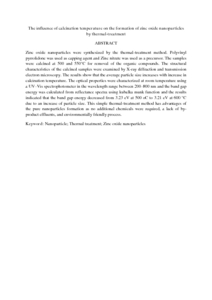Citation
Al-Hada, Naif Mohammed and Saion, Elias and Shaari, Abdul Halim and Ahmad Kamarudin, Mazliana and Gene, Adamu Salahudeen
(2014)
The influence of calcination temperature on the formation of zinc oxide nanoparticles by thermal-treatment.
Applied Mechanics and Materials, 446-447.
pp. 181-184.
ISSN 1660-9336; ESSN: 1662-7482
Abstract
Zinc oxide nanoparticles were synthesized by the thermal-treatment method. Polyvinyl pyrrolidone was used as capping agent and Zinc nitrate was used as a precursor. The samples were calcined at 500 and 550°C for removal of the organic compounds. The structural characteristics of the calcined samples were examined by X-ray diffraction and transmission electron microscopy. The results show that the average particle size increases with increase in calcination temperature. The optical properties were characterized at room temperature using a UV–Vis spectrophotometer in the wavelength range between 200–800 nm and the band gap energy was calculated from reflectance spectra using kubalka munk function and the results indicated that the band gap energy decreased from 3.23 eV at 500 oC to 3.21 eV at 600 °C due to an increase of particle size. This simple thermal-treatment method has advantages of the pure nanoparticles formation as no additional chemicals were required, a lack of by-product effluents, and environmentally friendly process.
Download File
![[img]](http://psasir.upm.edu.my/35726/1.hassmallThumbnailVersion/The%20influence%20of%20calcination%20temperature%20on%20the%20formation%20of%20zinc%20oxide%20nanoparticles%20by%20thermal-treatment.pdf)  Preview |
|
PDF
The influence of calcination temperature on the formation of zinc oxide nanoparticles by thermal-treatment.pdf
Download (74kB)
| Preview
|
|
Additional Metadata
Actions (login required)
 |
View Item |

